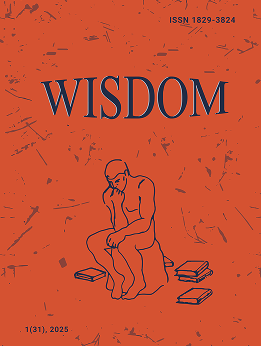Social-Psychological and Legal-Philosophical Characteristics of Personality Anomie
DOI:
https://doi.org/10.24234/wisdom.v24i4.950Keywords:
anomie, legal-philosophical, social-psychological, social norms, value orientations, personAbstract
The key to the successful and effective development of any society is the socio-psychological well-being of the population and personality, based on certain legal and philosophical concepts. Modern society experiences a kind of civilizational, philosophical, legal and socio-psychological crisis - the transformation of norms and behavior, against the background of which various forms of deviation are clearly manifested. As a result, in the context of the transformation of society, for a more complete and deeper study of the characteristics of human behavior, it becomes necessary to understand the causes of their occurrence. This methodological position allows first of all describing the mental world of a person who acts in the frames of the certain understanding and perception of social-psychological and legal norms of behavior. In this context, the procedure of psychological and legal-philosophical reconstruction of scientific concept of anomie is used as a methodological tool, which is aimed at analyzing various manifestations of the psyche of the personality and its anomic characteristics.
Downloads
References
Agnew, R. (2006). Pressured into crime: An overview of general strain theory. Los Angeles: Rox-bury Publication.
Anheier, H. (2015). Institutions and infrastructure of the social and behavioral sciences. In International encyclopedia of the social & behavioral sciences (pp. 59-66). (2nd ed). Elsevier.
Antonyan, Y. (2022). Otchuzhdeniye lichnosti kak prichina prestupnosti (Alienation of the individual as a cause of crime, in Russian). Œbshchestvo i pravo (Society and Law, in Russian), 2(8), 8-19.
Brokgauz, F., & Yefran, I. (1896). Entsiklopedicheskiy slovar (Encyclopedic dictionary, in Russian). (Vol. XVII). Saint Petersburg: Semenovskaya Tipolitografiya I.A. Yefrona.
Burova, Ju., & Koval, E. (2014). Normativnye osnovaniya mekhanizmov preodolenia dezadapta-ciisovremennoj molodyoji v usloviakh socialínoj anomii (Mechanisms of normative basis of modern youth desadaptation overcoming in the conditions of social anomie, in Russian). Sa-ransk: Krasniy oktyabr Publication.
De Winter, J., & Dodou, D. (2012). Factor recovery by principal axis factoring and maximum like-lihood factor analysis as a function of factor pattern and sample size. Journal of Applied Sta-tistics, 39(4), 695-710. DOI: https://doi.org/10.1080/02664763.2011.610445
Freud, S. (2005). Massenpsychologie und Ich-Analyse. Die Zukunft einer Illusion (Group psychology and the analysis of the ego: The future of an illusion, in German). Frankfurt-on-Main: Fischer Verlag Publication.
Fromm, E. (1994). The anatomy of human destructiveness. New York: Holt Rinehart & Winston Publication.
Geary, D. (2013). Children of the lonely crowd: David Riesman, the young radicals, and the split-ting of liberalism in the 1960s. Modern Intellectual History, 10(3), 603-633. DOI: https://doi.org/10.1017/S1479244313000231
Hagan, F. (2010). Introduction to criminology: Theories, methods, and criminal behavior. New York: SAGE Publication.
Hakobyan, N., Gevorgyan, S., Petrosyan, L., & Khachatryan, A. (2022). The problem of personal development in the context of social anomie. WISDOM, 2(22), 7-14. https://doi.org/10.24234/wisdom.v22i2.749 DOI: https://doi.org/10.24234/wisdom.v22i2.749
Harutyunyan, M. (2014). Ardi hay hasarakutyuny yev otarvats gitaktsutyan pilisopayutyuny (Modern Armenian society and the philosophy of alienated consciousness, in Armenian). Yerevan: Nairi.
Hezemans, F. H., Wolpe, N., & Rowe, J. B. (2020). Apathy is associated with reduced precision of prior beliefs about action outcomes. Journal of Experimental Psychology: General, 149(9), 1767-1777. DOI: https://doi.org/10.1037/xge0000739
Hornsey, M., & Hogg, M. (2000). Assimilation and diversity: An integrative model of subgroup relations. Personality and Social Psychology Review, 4(2), 143-56. DOI: https://doi.org/10.1207/S15327957PSPR0402_03
Kara-Murza, S. (2013). Anomiya v Rossii: prichini i proyavlenia (Anomie in Russia: Causes and manifestations, in Russian). Moscow: Nauchniy expert Publication.
Kazanchian, L. (2018). Ponyatiye ìlichnost'î v kontekste pravovogo polozheniya lichnosti (“he concept of ìpersonalityî in the context of the legal status of the individual, in Russian). Yevraziyskiy yuridicheskiy zhurnal (Eurasian Law Journal, in Russian), 1(116), 100-101.
Kuzmenkov, V. (2018). Lichnostnyye faktory anomii (Personal factors of anomie, in Russian). Intellekt. Innovatsii. Investitsii (Intellect. Innovation. Investments, in Russian), 7, 71-74.
Lafaye, C. (2012). Anomie, exclusion, desaffiliation: Dissolution de la cohesion sociale ou du lien social?? Pensee Plurielle, 1(29), 11-35. DOI: https://doi.org/10.3917/pp.029.0011
Levin, D., & Cross, R. (2004). The strength of weak ties you can trust: The mediating role of trust in effective knowledge transfer. Management Science. 50(11), 1477-1490. DOI: https://doi.org/10.1287/mnsc.1030.0136
MacIver, M., & Riesman, D. (1950). The ramparts we guard. New York: Macmillan Company Publication.
Merton, R. (1938, October). Social structure and anomie. American Sociological Review, 3(5), 672-682. https://doi.org/10.2307/2084686 DOI: https://doi.org/10.2307/2084686
Napso, M. (2017). Teoria anomii E. Durkheima i sovremenností (Theory of anomie of E. Durkheim and modernity, in Russian). Sociodinamika (Sociodynamics, in Russian), 2, 22-30.
Parsons, T. (2006). The sociology of knowledge and the history of ideas. In H. Staubmann (Ed.), Action theory: Methodological studies (pp. 31-82). LIT Verlag, Wien Publication.
Powell, E. (1958). Occupation, status and suicide: Toward a redefinition of anomie. American Soci-ological Review, 23( 2), 131-139. DOI: https://doi.org/10.2307/2088996
Rubinshtein, S. (2003). Bytiye i soznaniye. Chelovek i mir (Being and consciousness. Man and the world, in Russian). Sankt-Peterburg: Pite.
Schaefers, T., Wittkowski, K., Benoit, S., & Ferraro, R. (2016). Contagious effects of customer misbehavior in access-based services. Journal of Service Research, 19(1), 3-21. DOI: https://doi.org/10.1177/1094670515595047
Srole, L. (1956). Social integration and certain corollaries: An exploratory study. American Socio-logical Review, 21, 709-716. DOI: https://doi.org/10.2307/2088422
Zhelnina, A. (2020). The apathy syndrome: How we are trained not to care about politics. Social Problems, 67(2), 358-378. DOI: https://doi.org/10.1093/socpro/spz019
Downloads
Published
How to Cite
Issue
Section
License
Copyright (c) 2022 Naira HAKOBYAN, Lilit KAZANCHIAN, Laura PETROSYAN, Anna KHACHATRYAN

This work is licensed under a Creative Commons Attribution-NonCommercial 4.0 International License.
Creative Commons Attribution-Non-Commercial (CC BY-NC). CC BY-NC allows users to copy and distribute the article, provided this is not done for commercial purposes. The users may adapt – remix, transform, and build upon the material giving appropriate credit, and providing a link to the license. The full details of the license are available at https://creativecommons.org/licenses/by-nc/4.0/.















